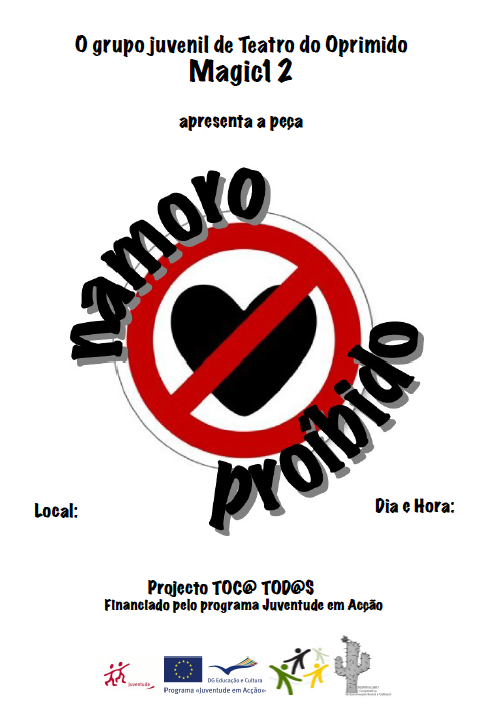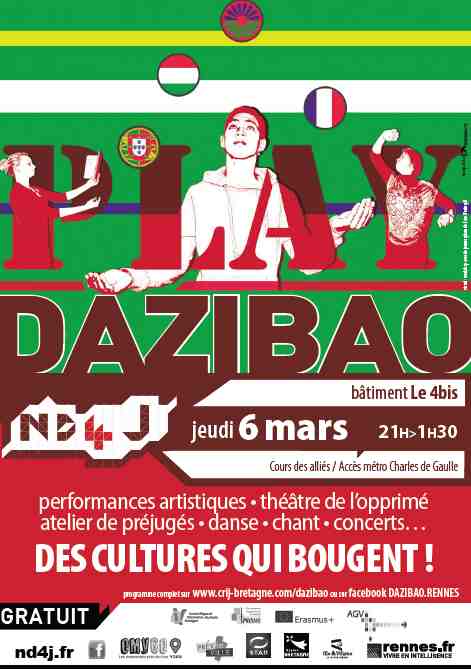Play – Cultures on the move!

This example shows that if there is a combination of opportunities, support and space, Roma young people can work towards participation semi-independently. The project has been a means for a group of young Roma to understand how they can play an active role in society. It has seen them addressing their individual and collective concerns. The project has also been an important step in celebrating their own identity, another part of the participation picture of this example. One of the most important aspects of participation that this example provides is through the sense of solidarity the Roma and non-Roma young people were able to promote.
Keywords for participation: Space / Opportunity / Support / Identity
Isolated Community

There are around 230 people living in Horta da Areia, which is situated in the industrial area of Bom João. Horta da Areia is bordered by the Commercial Wharf Road and a nature reserve, Ria Formosa. As such, this housing district is geographically separated from the main residential areas of Faro. Approximately half of the district’s population are Portuguese Roma.
As with other social housing districts, there are problems relating to housing, environment, education and employment. Young people particularly have difficulties in terms of accessing education and employment.
The social participation of some groups of young women living in this area is restricted by cultural expectations. This includes the taking on of roles related to domestic labour in the home, sibling child care and supporting elderly family members. There is also, in some instances, a social expectation that young women will marry and have children at a young age.
Cooperativa Mandacaru and Fundação António Silva Leal – Portugal
In 1996 an integrated community development project was initiated with the aim of addressing some of the challenges of life in Horta da Areia. One of the outcomes of this project was the creation of the Community Centre. Mandacaru, a social and cultural co-operative, is based in the centre and the Foundation António Silva Leal, and has been running Theatre of the Oppressed workshops in the centre since 2010.
Play – Cultures on the Move
Initially, two mixed-gender groups were created, made up of both Roma and non-Roma. Through the exploring of subjects and issues, they prepared public performances using Theatre of the Oppressed. Eventually a core group emerged, taking the title ‘Magic Twelve’. This group is made up of 12 young people, aged between 13 and 18. The majority of this group come from Roma backgrounds, although some are non-Roma. The group is keen to become autonomous and self-sustaining. It is with this in mind that the young people plan to create their own organisation.
The organisers realised that the project needed to tackle participation on two fronts: firstly, within the social context of being a young Roma in the Roma community and culture (inside), and secondly, being a young Roma in the wider society (outside).
Concerning “inside”, the young people explored the cultural limitations and the restrictions of tradition. They grew in understanding of the potential oppression of customs and habits, and explored ways of being able to participate in their communities despite these restrictions.
The “outside” approach consisted mostly of the public performances. This is where they could promote a positive understanding of Roma identity, where they could question stereotypes, challenge prejudices, and raise awareness of the consequences of discrimination for Roma young people. They were able to make these issues relate directly to specific manifestations of prejudice and inequality that impact on Horta de Areia and on them as young people from that community.
Theatre of the Oppressed
Variations of the Theatre of the Oppressed methodology have been used for many years around the world as a means of personal and group exploration, and the discovery and expression of social positions and intentions. The process comprises dramaturgical techniques and approaches whereby actors and audience become involved in developing and elaborating a performance. This, together with other activities, related to human rights education, has been used in order to offer participants a means to analyse, shape, express and transform perspectives. Ultimately, the concept of the theatre is to formulate action focused on advancing equality, fairness and justice for all, providing a potential spark to ignite social and political change.
Through the public performances the young people showed how young Roma, working with their non-Roma peers, contribute to the recognition and celebration of the Roma identity. It offered the potential for intercultural learning among the young people. Working together, the young people were able to question and undermine stereotypes, while at the same time develop skills related to communication and co-operation. The events also offered audiences a chance to raise their consciousness of the shared reality of Roma and non-Roma with regards to discrimination against young people. Together with the audience, there was also an opportunity to participate in looking for ways to address and alleviate this discrimination.
Participation in Action
It was important that the participation of the young people started right from the beginning in this project. When the idea of creating the project was initially put to the young people, it was agreed that they could attend when they wanted and manage the organisation of the project. The young people chose what they wanted to present through the theatre methodology, when they wanted to practise and when they would perform. They controlled the process.
The community centre offered the space for participation, both through the proposal of the project idea and with the physical space to meet and work. The young people had access to the building and it was a building they were encouraged to see as theirs – along with the rest of the community of Horta da Areia.
Overall the project provided the young people with the opportunity and means to discuss, formulate and analyse issues that were relevant to them. These included discrimination at school, poverty, health, and sexuality questions. This was the seed of “political” participation; it was the means of motivating the young people to raise their voice and push for change.
A key factor in the project was that it was mostly the young Roma women who led the process. They became role models for other young women in the community. Through the activities, the young women became more aware of their situation and at the same time this served as a consciousness-raising opportunity for the young men. The young women were able to exert influence and take authority for the development of the project. It was their responsibility to engage with the audiences in order to realise and grasp the nature of oppression and its relationship to identity. The Roma young women’s participation pushed the boundaries of the traditional roles often associated with young Roma women, pushing back against the “inside” forms of oppression.
The young people acted as advocates for their own and others' rights. At the same time they invited other members of society to become part of this process. This active participation through theatre provided Roma young people with the opportunity to cultivate and preserve their identity, and to celebrate and question life-style choices and traditions. It is the young people themselves who have provided new opportunities, accessing space, tools, and resources to make their own decisions.
Outcomes
The project raised the consciousness of both the Roma and non-Roma young people about their own experiences of discrimination and prejudice. It provided opportunities for the young people to make more sense of their social and political context. It showed the young people involved that change is possible and that young people (Roma and non-Roma) have their own voice: they are responsible and can decide for themselves about how to live their lives.
The outcome is that the project is continuing because the young people make it continue.


